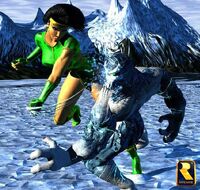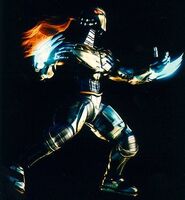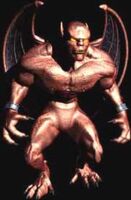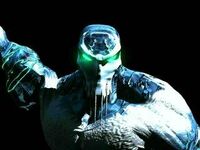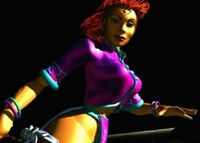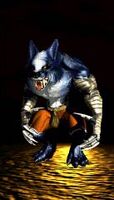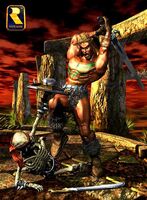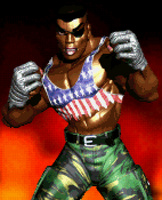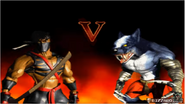Killer Instinct 2 (commonly abbreviated as KI2) is a 1996 arcade fighting game, and the sequel to Killer Instinct. Like its predecessor, the game features two 8-way joysticks with six buttons each for attacks (three punch and three kick), allowing for both a single player mode or a two player versus mode. KI2 was ported to the Nintendo 64, known as Killer Instinct Gold, in 1996.
Overview
As with most fighting games and indeed its predecessor, two characters square off with the goal of depleting the opponent's life bar. As with the original Killer Instinct, when a player's original life bar is fully depleted, he or she will fall to the ground, and immediately begin on his or her second lifebar.
As with the first game, Killer Instinct 2 relies on an automatic combo subsystem in its matches. The matches, as with Killer Instinct, revolve around a three strength system (Quick, Medium, and Fierce.) However, normal moves have lost a lot of their priority and range, as well as gaining extra recovery time. Throws have been added into the game to deal with blocking characters (as opposed to the top attack in Killer Instinct.) Additionally, characters can be knocked down much easier with normal moves than in the first game, ending the possibility of opening with a 'glitch' combo and also weakening the effectiveness of normal moves. Normal special moves no longer are judged on priority, but instead follow a three tiered 'rock, paper, scissors' system, in which a certain special move will always break another certain special move (similar to the three tiered system in Soul Calibur.) The system has been seen as flawed due to little differences between the special moves themselves.
Additionally, a Super bar has been added to the game (similar to Street Fighter Alpha or King of Fighters). This super bar fills as players take damage. After the bar reaches a certain point, the player can use a multi-hit super special move (normally referred to as Super Move,) which is usually an extended version of a normal special move.
The combo system has its roots in the original Killer Instinct. By pressing a certain strength button after an opener move, a player will launch an auto-double and initiate the combo system of the game. However, unlike the first game, players can now open up combos with new and much less risky moves than before (most notable a close Fierce punch or close Fierce kick.) Additionally, Super Moves can be placed into combos, greatly increasing their damage and potency as well as being unbreakable. Additionally combos can be extended using throws, super linkers, manual-doubles, and super end specials.
As a result of the weakened normal moves and other changes to the system, combos have now become more devastating in Killer Instinct 2. In an apparent effort to help ease this dominance, combo breakers are now easier to perform. Unlike combo breakers in the first game, which also required a three tiered 'rock, paper, scissors' system based on strength to break, combos are now broken depending on the type of attack. Punches break kick doubles, and kicks will break punch doubles.
As popular as its predecessor was this next installment, in addition to praise, was criticized for its more liberal combo engine which changed the dynamics of the game considerably.
Parry, an advanced new addition, allow an open counter-attack after a successful parry block. A player can assume a standing defensive position and cause the attacker to temporarily freeze if the parry is successful.
The finishing moves have also been reworked. Now each character can only execute these attacks when the opponent's second life bar flashes red (unlike the first Killer Instinct the opponents falls when he or she loses all of his or her energy bars). Each characters has two Ultimate combo moves (one of them can be executed without executing a combo), the Humiliation sequences were dropped, and the Ultra combo feature is still intact.
Endings
Each character in the game has two or four different endings. Which ending the player gets depends whether or not the player kills (by using a finishing move vs. simply depleting their health) one or more certain character(s) during the course of the game.
For example, Jago's endings both involve Fulgore and Orchid. Thus, killing or not killing them over the course of the game alters the outcomes of his endings.
- If he kills both of them, he relishes his victory over Fulgore, but feels an inexplicable emptiness in his heart.
- If he kills Orchid but doesn't destroy Fulgore, the cyborg will eventually make a lethal attack on him after he wins the tournament, and fulfills Ultratech's original purposes by seizing control of the world.
- If he kills Fulgore but spares Orchid, his enjoyment of his enemy's demises is only sweetened by the discovery that Orchid is his older sister.
- If he spares both their lives, he makes that discovery when she saves him from Fulgore's attack.
Story
Killer Instinct 2 follows on from the plot line that the previous installment ended with. Eyedol's death at the hands of Orchid accidentally sets off a time warp, transporting some of the combatants back in time and allowing the Demon Lord Gargos to escape from Limbo. Now, trapped 2000 years in the past, the warriors that survived Killer Instinct, along with several new faces, fight for the right to face Gargos in combat, but Chief Thunder, Cinder and Riptor did not return. Each character that survived the journey from the first game has a corresponding background story, while new characters on this installment are native inhabitants of this past time period. Some fighters, like T.J. Combo who survives from the original, just want to get home. Others, like new character Tusk, want to bring an end to Gargos and his reign of evil. This time there is no tournament or prize money, just a fight to the finish with the fate of the future hanging in the balance.
Characters
Returning characters

|
Black Orchid, who killed Eyedol in the previous tournament. Doing so freed massive energies, ripping Ultratech back in time. Now two-thousand years in the past, Orchid must face a new challenge and even greater foe. |

|
Fulgore is the advanced and deadlier successor to the original Fulgore cyborg, which was destroyed by Jago. Activated after the time jump, its final Ultratech commands are excecuted... find Jago and kill him. |

|
Glacius, who has answered a distress call from his kin who are stranded on the Earth. Two millennia from now, one of his descendants was captured and earned his freedom by slaying Cinder and escaping home. |

|
Jago succeeded in destroying Fulgore, but is furious now that he has been betrayed by what he thought to be his master, the Tiger Spirit. The disguised warlord used him to escape from Limbo, and now Jago swears vengeance. |

|
Sabrewulf was badly beaten in the tournament after refusing to succumb to the beast within. Captured and experimented on by Ultratech, he is driven berserk by their "repairs" and now only has revenge to live for. |

|
Spinal was destroyed by Thunder in the first tournament. Gargos, however, has control of a skeletal warrior of his own in the past. Resurrected and forced to serve him, Spinal goes up against the warlord to win his freedom. |

|
TJ Combo, who attempted to destroy Ultratech headquarters after a decisive victory over Riptor in the tournament. He is caught as Ultratech is ripped into the past, and now he must escape home before it is too late. |
New characters

|
Gargos is a demonic warlord who is Eyedol's ultimate rival. While Eyedol was trapped in Limbo, Gargos disguised himself as the Tiger Spirit and began exerting his influence through Jago. With his enemy Eyedol now taken care of for him, Gargos makes his move to take over the world. |

|
Kim Wu is a martial artist and descendant of the heroes who long ago banished Eyedol and Gargos from the world. She has been appointed her people's guardian, and with the return of Gargos, Kim must fulfill her duty to her home by destroying him forever. |

|
Maya is an Amazonian queen who was one of the original heroes responsible for banishing Eyedol and Gargos. Exiled by her people after Gargos' reappearance, her goal is to destroy the demon lord once and for all and regain her standing. |

|
Tusk is the warrior champion of the ancient world. With the return of Gargos to the land, Tusk leaves the arena to issues his challenge. Only by defeating all adversaries can a hero earn the right to face the evil warlord. |
Versions
Arcade
Killer Instinct Gold


Killer Instinct Gold is the Nintendo 64 port of Killer Instinct 2. It was released shortly after the launch of the console. Akin to the SNES port of the first game, it received some cutbacks due to the hardware limitations of the Nintendo 64 cartridge: the game suffered some major graphical downgrades (most of its FMV scenes and several frames of character animation were completely removed, sprites' animation quality was decreased), and the victory FMVs had to be replaced with a simple animation consisting of a zoom of the character the player was using. The game also lacks the secondary character endings as found in the arcade version.
To compensate the loss of animations, stages in the game are fully rendered in 3D, as opposed to the scaling and distorting FMVs used for the stage backgrounds in the arcade version, allowing a more dynamic camera when starting a fight, while using less memory consumption.
Gameplay-wise, however, Killer Instinct Gold ultimately remains faithful to the original Killer Instinct 2.

Fitting for a console port, Killer Instinct Gold contains extra modes and content. This includes:
- Team Battles, in which one can fight with up to 11 characters.
- Team Elimination Battles, in which one has to finish his or her opponents off with Fatals (finishing moves similar to Mortal Kombat's Fatalities, which can be executed immediately) instead of simply depleting their life bar with normal moves, or they will simply return later on in the match (however as the computer player will sometimes use Gargos as the last opponent, victims can be removed from play anyway as he lacks a finishing move).
- Training and Advanced Training, in which the player can learn the moves of the character they have chosen as well as the correct execution of combos, doubles, auto-doubles link moves, etc.
- Options menu, which allows the player to modify certain data, such as the speed of the game, the color of the blood, button configuration, sound and manage Controller Pak data.
- Unlockable content, such as alternate colors for characters and scenarios, and faster degrees of speed for the game.
KI Gold is compatible with the Nintendo 64's Controller Pak to save options and high scores, though the cartridge also includes battery save.
Later Re-Release
On August 4, 2015, KI Gold was included in an Xbox One exclusive (and worldwide-released) compilation of 30 of the original developer Rare's titles called "Rare Replay", complete with emulated graphics and gameplay, exclusive features, unlockables, and new Gamerscore Achievements.
Merchandise

|
Killer Instinct Gold Cuts is the original soundtrack based on Killer Instinct Gold. It consisted in a 16-track-audio-CD, which included original tracks from the Arcade versions plus two remixes and the Training Mode track. |
Reception
Cast (Voices)
- Kevin Bayliss (Reused Audio) - Fulgore, Glacius and Jago
- Keri Gunn - Maya
- Ken Lobb - Gargos
- Isaac Marshall - TJ Combo
- Don Murphy - Focused Training Announcer (Killer Instinct Gold)
- Chris Seavor - Spinal and Spinal Head
- Adrian Smith - Tusk
- Louise Stamper - Black Orchid
- Chris Sutherland - Announcer
- Keiko Tamura - Kim Wu
- Armond Williams Jr. - Glacius
- Hiroyuki Yamada and Shigeki Yamashiro - Jago











